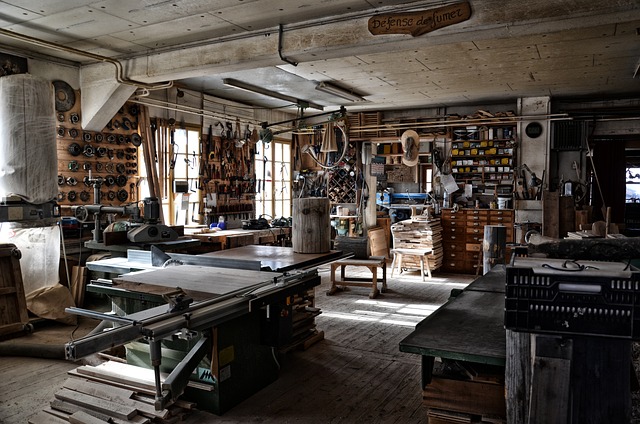A carpenter's role is pivotal in constructing and repairing wooden structures, ensuring they are both durable and aesthetically pleasing. Expert carpenters select appropriate wood types, considering moisture resistance and grain direction for optimal longevity and joint strength. They employ precise cutting and fastening techniques, such as interlocked corner joints and structural screws, to create sturdy frames that comply with building codes. The careful selection of timber, including softwoods like spruce and pine or hardwoods like oak and mahogany, is critical for different uses and environmental exposures, with cedar and teak often favored for outdoor applications due to their natural resistance to moisture.
Carpenters must also install joists and rafters correctly to ensure the wooden structure's robustness and stability. They blend traditional craftsmanship with modern technology, using tools like laser levels and power saws to create precise, level surfaces essential for the overall structural integrity. Sheathing with plywood or OSB secures the framework against environmental factors and provides a smooth surface for siding and finishes.
Bracing is applied to counteract lateral forces and enhance stability, with techniques like diagonal braces and shear walls tailored to specific building codes and site conditions. Carpenters choose the appropriate bracing method, whether through toe-nailing, bolted connections, or engineered systems, to ensure safety and durability.
Energy efficiency is also a key concern for carpenters, who select and install effective insulation and vapor barriers to maintain consistent temperatures and prevent moisture accumulation that could lead to mold, wood rot, and diminished insulation performance. The placement of these materials must be precise to ensure the wooden construction remains comfortable and energy-efficient over time. Carpenters' expertise in these areas is essential for creating structures that are not only structurally sound but also sustainable and livable.
Embarking on the construction or repair of wooden structures, from framing to finishing, demands a blend of skill, knowledge, and hands-on expertise. This comprehensive guide delves into the carpentry craft, offering insights and best practices for every stage of wooden structure development. From selecting durable timber to mastering intricate siding and roofing techniques, our exploration covers essential aspects of carpentry work that ensure both functionality and aesthetic appeal. Carpenters play a pivotal role in these projects, with their expertise critical to achieving structural integrity, energy efficiency, and long-term durability. This article provides an in-depth look at the various facets of carpentry, including material selection, installation methods, and protective finishes, culminating in a polished final product. Whether you’re a seasoned professional or a DIY enthusiast, this guide will equip you with the knowledge to tackle wooden construction projects with confidence.
- Understanding Wooden Structure Framework: The Role of a Carpenter in Laying Foundations
- Selecting the Right Timber: A Carpenter's Guide to Material Choices for Durability and Performance
- Mastering Joist and Rafter Installation: Techniques for a Strong and Stable Wooden Structure
- Effective Sheathing and Bracing Methods: Enhancing Structural Integrity with a Carpenter's Expertise
- Insulation and Vapor Barrier Integration: Best Practices for Energy Efficiency in Wooden Constructions
Understanding Wooden Structure Framework: The Role of a Carpenter in Laying Foundations

When constructing or repairing wooden structures, from modest cabins to expansive residential complexes, the carpenter’s role in laying robust foundations is paramount. A carpenter’s expertise is pivotal in assembling the wooden framework that forms the backbone of any wooden structure. This framework, often referred to as the skeleton, must be precise and sturdy to ensure structural integrity and longevity. The carpenter begins by carefully selecting materials suitable for the task at hand, considering factors like moisture resistance, grain direction, and wood type. This selection process is critical, as it determines the strength and durability of joints and connections within the framework.
Once the materials are chosen, the carpenter employs various techniques to cut, shape, and join pieces with precision. The framework’s design must account for the structure’s intended use, the forces it will endure, and local building codes. Common practices include the use of interlocked corner joints, structural screws, and hidden fasteners that are both aesthetically pleasing and functionally sound. The carpenter’s skill in aligning components and ensuring every connection is secure lays the foundation for the subsequent stages of construction, from insulation to finishing. This meticulous work at the outset saves time and resources later on, as it minimizes the risk of structural failure or the need for costly repairs down the line.
Selecting the Right Timber: A Carpenter's Guide to Material Choices for Durability and Performance

When a carpenter embarks on constructing or repairing wooden structures, from robust framing to the delicate art of finishing, selecting the right timber is paramount. The durability and performance of the final product are heavily dependent on the quality and type of wood chosen. Each species of timber offers distinct properties; some are more resistant to rot and decay, while others boast greater strength or a finer grain for aesthetic purposes. A carpenter must consider factors such as the structure’s intended environment, exposure to elements, load-bearing requirements, and the desired lifespan of the project.
For instance, softwoods like spruce and pine are often used for framing due to their lightweight nature and ease of working with hand or power tools. In contrast, hardwoods such as oak and mahogany, renowned for their density and strength, are suitable for both load-bearing applications and fine joinery. Additionally, certain hardwoods like cedar and teak have natural resistance to moisture, making them ideal for outdoor furniture or cladding where resistance to the elements is crucial. A carpenter’s knowledge of wood species and their characteristics enables informed decisions that ensure the longevity and integrity of the wooden structures they craft. It’s through this meticulous selection process that a carpenter can guarantee the best possible outcome for both functionality and aesthetics in their projects.
Mastering Joist and Rafter Installation: Techniques for a Strong and Stable Wooden Structure

A skilled carpenter understands that the integrity of a wooden structure hinges on the precision and care taken during the installation of joists and rafters. These critical components form the backbone of any wood-framed construction, providing both the structural support and the framework upon which other elements depend. To ensure a strong and stable wooden structure, carpenters employ various techniques that combine time-honored craftsmanship with modern technological advancements.
The process begins with meticulous planning, taking into account the span, load, and orientation of the building. Carpenters must accurately calculate the required length and angle of each joist and rafter to ensure proper alignment and support distribution. Once on-site, the carpenter aligns the first joist or rafter with reference points established during the planning phase, securing it in place with temporary fasteners. Subsequent joists and rafters are then installed by creating precise cuts where necessary, ensuring that each new addition aligns perfectly with its counterparts. The use of advanced tools like laser levels and power saws, combined with traditional carpentry skills, allows for the creation of seamless and level planes, which are essential for the structure’s overall stability. Throughout this process, the carpenter pays close attention to building codes and safety standards, as compliance is crucial for both the structural integrity of the wooden structure and its occupants’ well-being.
Effective Sheathing and Bracing Methods: Enhancing Structural Integrity with a Carpenter's Expertise

Effective sheathing and bracing are pivotal in ensuring the structural integrity of wooden structures, from residential homes to commercial buildings. A skilled carpenter understands that sheathing serves as the framework’s protective layer against environmental elements while providing a flat, stable surface for siding and other finishes. The choice of sheathing materials, such as plywood or oriented strand board (OSB), depends on factors like budget, load-bearing requirements, and exposure to moisture. Carpenters apply these materials with precision, ensuring they are properly fastened to prevent warping or splitting.
Bracing, on the other hand, is a critical component in providing lateral stability to wooden frames. It counteracts the natural forces of wind and seismic activity that can cause structural failure. Carpenters employ various bracing methods, including crisscrossing diagonal braces within wall panels and installing vertical shear walls. These techniques not only reinforce the structure but also allow for flexibility in design and adaptation to different building codes and site-specific conditions. The expertise of a carpenter in selecting the appropriate type of bracing, whether it be through toe-nailing, bolted connections, or advanced engineering systems, is essential for a safe and durable construction. By combining effective sheathing with strategic bracing, carpenters enhance the resilience and longevity of wooden structures, ensuring they stand firm against the test of time.
Insulation and Vapor Barrier Integration: Best Practices for Energy Efficiency in Wooden Constructions

When integrating insulation and a vapor barrier within wooden structures, the expertise of a skilled carpenter is paramount to achieve energy efficiency and ensure long-term performance. Properly installed insulation serves as a critical layer that maintains temperature stability within the wooden construction, reducing heating and cooling costs for occupants. A carpenter must carefully select appropriate materials, such as spray foam, fiberglass, or cellulose, based on the R-value requirements of the building envelope, ensuring that the structure is adequately protected against thermal loss in colder climates and heat gain in warmer regions.
In conjunction with insulation, a vapor barrier becomes an essential component to prevent moisture buildup, which can lead to mold growth, wood rot, and decreased insulation effectiveness. A carpenter should install the vapor barrier on the warm side of the insulation, typically on the interior or exterior surface depending on climate conditions. The barrier must be seamless and impermeable to water vapor yet allow for the natural movement of air. This careful consideration of material selection and installation technique by a carpenter is not only critical for energy efficiency but also for maintaining the structural integrity and comfort of the wooden construction over time.
In conclusion, constructing and repairing wooden structures, from the foundational framing to the meticulous finishing touches, is a multifaceted endeavor that demands expertise in material selection, structural integrity, and energy efficiency. A skilled carpenter’s role is pivotal, encompassing understanding the framework of wood structures, choosing the appropriate timber for longevity and performance, mastering the installation of joists and rafters, and ensuring sheathing and bracing methods are effective to maintain a robust frame. Additionally, integrating insulation with vapor barriers is crucial for optimizing energy efficiency within wooden constructions. By adhering to these best practices, carpenters not only craft structures that stand the test of time but also contribute to more sustainable and comfortable living environments.
